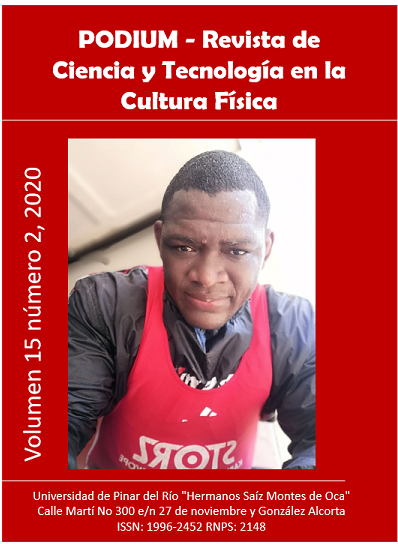Motivación de los boxeadores cubanos de élite: un indicador de rendimiento
Contenido principal del artículo
Resumen
La presente investigación tiene como objetivo determinar el desarrollo de las cualidades en cuanto a la motivación, en boxeadores cubanos de elite. Se tomó una muestra intencional de 20 boxeadores cubanos de elite, diez destacados y diez no destacados. Este estudio tiene como objetivo determinar el desarrollo de las cualidades de la motivación en boxeadores cubanos de elite. Como método empírico se emplea el cuestionario de cualidades motivacionales que evalúa trece variables de motivación. Se realizó el análisis estadístico de los datos con el SPSS, versión 21.0, como medida de asociación entre el nivel del deportista y el puntaje alcanzado en las cualidades motivacionales se utilizó la prueba Chi Cuadrado de Pearson. Aun cuando los niveles de significación estadística se expresan sólo en una cualidad, una revisión detenida a los datos, informa acerca de la superioridad motivacional perceptible del grupo de boxeadores destacados sobre los no destacados. Como parte de los resultados preliminares se considera la presencia de una muestra de estudio con destacadas potencialidades motivacionales.
Descargas
Detalles del artículo
Citas
Gutiérrez, M. (2014). Relaciones entre el clima motivacional, las experiencias en educación física y la motivación intrínseca de los alumnos. Retos. Nuevas tendencias en Educación Física, Deporte y Recreación, 26, 9-14. Recuperado de: https://recyt.fecyt.es/index.php/retos/article/view/34387
Iglesias, X., Gasset, A., González, C., & Anguera, M. (2010). Interacción competitiva y presión ambiental en deportes de combate: Aplicación de la metodología observacional. Revista Iberoamericana de Psicología del Ejercicio y el deporte, 5(2), 267-282. Recuperado de: https://www.redalyc.org/pdf/2351/235129571018.pdf
Kokolakakis, T., & Gratton, C. (2019). The Economic Value of Sport. The SAGE Handbook of Sports Economics, 18(21).
Kolayis, H. (2012). Using EEG biofeedback in karate: The relationship among anxiety, motivation and brain waves. School of Physical Education and Sport, 8(1), 13-18. Recuperado de: https://www.researchgate.net/publication/274983727_Using_EEG_biofeedback_in_karate_The_relationship_among_anxiety_motivation_and_brain_waves
Más, M. A., & Alonso, Á. V. (1998). Validación de una escala de motivación de logro. Psicothema, 10(2), 333-351. Recuperado de: http://www.psicothema.es/pdf/169.pdf
Monroy, A., & Sáez, G. (2011). La motivación y el rendimiento en el deporte. Lecturas: Educación Física y Deportes, 16(163), 1-7. Recuperado de: https://www.efdeportes.com/efd163/la-motivacion-y-el-rendimiento-en-el-deporte.htm
Morales Neira, D. J., Caraballo, M., de la Caridad, G., Vera Puebla, E., Cuesta Mora, A., Neira Carbache, C., & Sandoval, J. (2017). Percepción del alumnado sobre condición física, relaciones interpersonales y desarrollo integral. Revista Cubana de Investigaciones Biomédicas, 36(2), 79-94. Recuperado de: http://www.revibiomedica.sld.cu/index.php/ibi/article/view/16
Moreno-Murcia, J. A., Marcos-Pardo, P. J., & Huéscar, E. (2016). Motivos de práctica físico-deportiva en mujeres: Diferencias entre practicantes y no practicantes. Revista de psicología del deporte, 25(1), 35-41. Recuperado de: https://www.researchgate.net/publication /284430946_Motivos_de_Practica_Fisico-Deportiva_en_Mujeres_Diferencias_entre_Practicantes_y_no_Practicantes
Muñoz, M. C., & García, J. F. (2013). Relación del disfrute en la actividad físico-deportiva con la autoeficacia motriz percibida al final de la infancia. QURRICULUM-Revista de Teoría, Investigación y Práctica Educativa, 26, 177-196. Recuperado de: https://dialnet.unirioja.es/servlet /articulo?codigo=4156301
Murcia, J. A., Gimeno, E. C., & Coll, D. G. (2006.). Motivación autodeterminada y flujo disposicional en el deporte. Anales de Psicología/Annals of Psychology, 22(2), 310-317. Recuperado de: https://dialnet.unirioja.es/servlet/articulo?codigo=2233211
Noriega, J. A., Germán, D. I., Carvajal, C., Carvajal, M. E., & Lam, E. T. (2019). Perfiles de motivación, éxito y sus características contextuales en estudiantes de educación media superior. Praxis investigativa ReDIE: revista electrónica de la Red Durango de Investigadores Educativos, 11(20), 8-22. Recuperado de: https://dialnet.unirioja.es/servlet/articulo?codigo=6951586
Perera, N. K., Åkerlund, I., & Hägglund, M. (2019.). Motivation for sports participation, injury prevention expectations, injury risk perceptions and health problems in youth floorball players. Knee Surgery, Sports Traumatology, Arthroscop, 27(11), 372. Recuperado de: https://www.ncbi.nlm.nih.gov/pubmed/30982108
Pileta, I. R., Pérez, H. M., Téllez, I. F., Bombú, R. M., Cevallos, E. C., & Calle, W. T. (2019). Análisis integral de la motivación en boxeadores. Revista Cubana de Investigaciones Biomédicas, 38(2), 56-72. Recuperado de: http://www.revibiomedica.sld.cu/index.php/ibi/article/view/276
Rodríguez, M. S., Prieto, Y. S., & Cañizares, M. (2018). Técnicas de intervención psicológica para elevar la concentración de la atención en boxeadores cubanos. Lecturas: Educación Física y Deportes, 22(238), 2-13. Recuperado de: https://dialnet.unirioja.es/servlet/articulo?codigo=7272728
Romero, X. A. V., & Lara, E. D. C. (2016). Los diferentes tipos de responsabilidad social y sus implicaciones éticas. Dominio de las Ciencias, 2(3), 117-126. Recuperado de: https://dialnet.unirioja.es/servlet/articulo?codigo=5802930
Sailema, M., Ruiz, P. M., Pérez, M. B., Cosquillo, J. L., Sailema, Á. A., & Vaca, M. R. (2017). El autoconcepto y la educación física en estudiantes de secundaria. Revista Cubana de Investigaciones Biomédicas, 36(3), 1-12. Recuperado de: http://www.revibiomedica.sld.cu/index.php/ibi/article/view/9
Sukprasert, D. (1996). The Study of Motivation of Becoming Thai Boxers [MA. Thesis]. Chulalongkorn University.
Villalba, M. P., Puyana, M. G., Rodríguez, V. A., & Sánchez-Oliver, A. J. (s. f.). Responsabilidad social corporativa en el deporte adaptado. EmásF: revista digital de educación física, 59, 65-71. https://dialnet.unirioja.es/servlet/articulo?codigo=6973258


